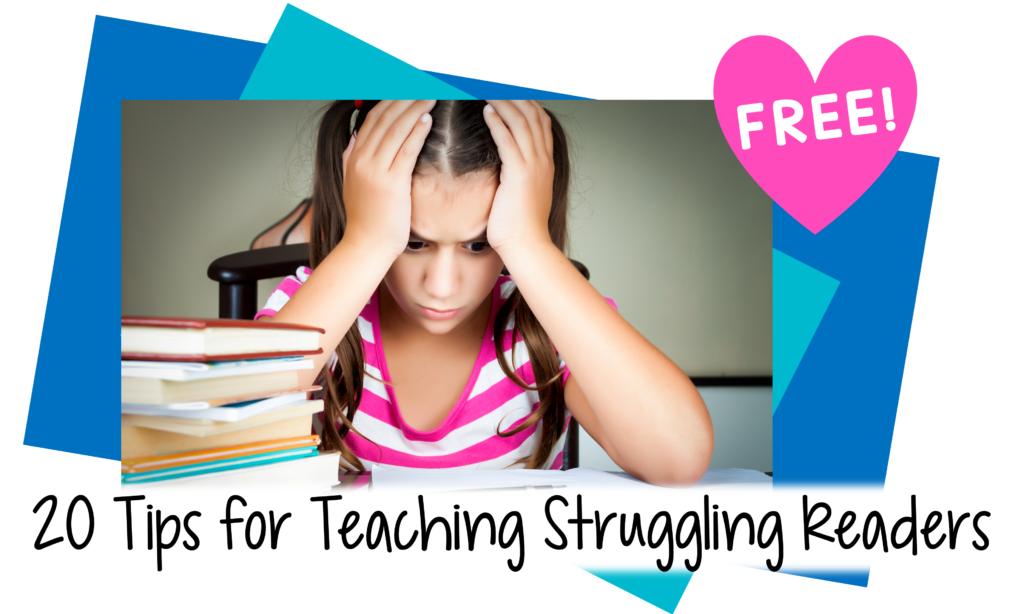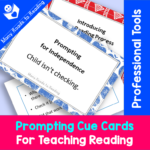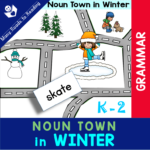
Keeping the students focused on school work during the weeks before winter vacation can be challenging for a teacher, under normal circumstances, but with the pandemic this year, holding their attention may require even more effort. Whether you are in the building, teaching remotely, or both, here are a few ideas to help you keep your primary grade students on task as their winter break approaches.
Use holiday-themed activities.
If you can’t beat ’em, join ’em! The children are going to be thinking about the upcoming holidays anyway, so you might as well choose activities that include holiday-related words and images. Holiday-related activities are highly motivating for children, and the meaningful semantic context seems to contribute to their ability to identify new holiday-themed words.
This is a great time for interactive read-alouds.
As you well know, reading aloud to children helps them in many ways: improved vocabulary, listening skills, attention span, language sense, and understanding of how books work.
But an interactive read-aloud does all that and more. To make your reading interactive, stop occasionally to discuss a new word, or to ask the children to respond to the text or an illustration. You will find that the class pays much better attention to a read-aloud when they know they can participate in it. Wouldn’t you? Below are some terrific holiday books for reading aloud.
Keep your activities as authentic as possible.
Learning is more apt to be effective if youngsters have a true purpose for their work. At this time of year, for example, your young students might put their hearts into writing letters to Santa. Here’s a 5-day lesson plan for writing a unique friendly letter to Santa, in which the children ask Santa to bring a Christmas gift to someone else. Teachers enjoy the way this writing activity encourages their students to think of others, to focus on giving, rather than receiving.
Remember the Gradual Release of Responsibility model.
With the frequently shifting school settings during the pandemic, it’s easy to forget about the Gradual Release of Responsibility model when planning our online lessons. Remember to first model for the students what you want them to do. Next, have the kids do the activity, but with your support, as needed. This scaffolding can take the form of prompts or cues, questions or answers. Finally, let the students work independently, assuming all the responsibility themselves.
Bring creativity into your lessons.
Children tend to stay focused on creative activities, especially if they know they will be sharing the project with their parents, presenting to other students, or making something for their grandparents. For creative writing projects, you may have the students respond on special paper or digitally, through SeeSaw, StoryJumper, Microsoft Whiteboard, or the Zoom whiteboard. When children are working remotely from home, they can write their creative work in a journal. After they have written the assignment in their journal, they can take a photo of it and email it to you. You can also combine students’ creations into a paper or digital class book.
Alternatively, you may want to have partners create videos or stop-action animations with one of the online video editing programs.
Most students are inspired to make gifts for Christmas or Hanukkah. One of my favorite gift projects is having the children write and illustrate character sketches of their parents, guardians, or themselves. Another is making a poetry ornament, a family memento for years to come.
Include some hands-on activities in your week.
Multi-sensory, hands-on activities tend to pull in even the most distractible students. Children are functioning on a concrete level, and multi-sensory activities are said to connect different parts of the brain. Noun Town is one such engaging project. In the paper Noun Town in Winter resource below, the students match seasonal words to images and place them on a map. (If you are teaching remotely, you can instead use the generic digital version of the original Noun Town by clicking here.
Sneak a game into the mix.
During the final day or two before vacation, it’s OK to add a game to your schedule. The kids will need a little down-time as vacation approaches–especially this year. You know me: I like the game to advance the students’ reading abilities, but that’s up to you. A holiday bingo game is great at this time of year. Here’s a digital board game.
 Take frequent breaks.
Take frequent breaks.
Whether your students are in the school building or learning remotely, it’s important to take breaks, but these off-times don’t have to be lengthy or unstructured. Simply having the children stand up and stretch for 20 seconds can help them to focus better. As they stretch, remind your students to take deep breaths. You can even teach them to meditate.
Address your students’ concerns about COVID.
Time spent dealing with social/emotional issues can save time in the long run, and addressing your students concerns can actually help them to concentrate better. This year the issues may revolve around COVID. The kids may be uncomfortable with remote learning, confused about the hybrid attendance structure, or upset that the schedule keeps changing. They likely miss their friends if they are at home, or are frustrated about keeping their friends at a distance, at school. Perhaps the children are afraid of getting the virus, or maybe even one of their family members has COVID or, God forbid, has died from it.
Let the students express their worries or disappointments, and acknowledge their feelings. It’s important that they be heard and feel heard. If one of the children did lose someone to the virus, you might want to have the class write sympathy notes to them.
But you also want to suggest some positive actions the students can take, so that the sharing time doesn’t degenerate into a complaint session. Review your school or district COVID policy, perhaps, or point out that, while the pandemic has limited their lives in some ways, it has also enabled some actions that weren’t available before (such as visiting their long-distance relatives through video conferencing or having their pet attend classes from home).
Make a gratitude list.
Thinking of what and whom they are thankful for can be a nice way to take the students’ minds off of the upcoming vacation, as well as their fears about COVID. If the students are at school, they may want to express their gratitude to the school nurse, custodian, or cafeteria workers with notes of appreciation. If working remotely, they might want to send thank you notes to their parents, grandparents, or to doctors and nurses who are taking care of COVID patients at the local hospital.
Introduce a Random Acts of Kindness project.
Last year, when my husband and I went to the local tree farm to buy a Christmas tree, the owner told us that the person before us had paid for our tree. That random act of kindness made us feel so good that we did the same for the next person, and this year we did it again. Random acts of kindness generate more acts of kindness.
You can give the children suggestions for acts of kindness they can do at home or at school. What a wonderful brainstorming session this can be. There are all sorts of ways to encourage RAK. One is having a jar into which the children write notes about the kind acts they did.
Here are some suggestions for RAK at school and at home.
Invite another group of children to your classroom.
This idea is a bit complicated this year due to the pandemic, so obviously it will only work for remote instruction, because of social distancing needs. You may want to have older children listen to younger children read in breakout rooms, or have different classes of the same grade level read to each other stories they have written. When the children know that another class is going to join them, they put a lot of effort into what they will be sharing. One possibility is to invite another class into a final presentation morning remotely, the last day before vacation.
Say good-bye with a Presentation Day.
You can schedule Presentation Day on the last day before vacation. The students are highly motivated to create quality projects when they know they will be reading or showing them to their families on Presentation Day. With COVID this year, we can’t invite parents into the classroom, but parents can join the class remotely, whether your students are in school or at home.
The children enjoy presenting the projects they have been working on: perhaps a play they wrote or practiced, an animation that teams created, dioramas they made, or creative writing they completed. This is a positive way to end the term and begin vacation — positive for the students, as well as for their parents. Anticipating Presentation Day has kept the children on task during the previous weeks, and the positive focused energy is remarkable during the event itself.
In the pre-COVID days, I would plan a class party after the presentations. The children would bring healthy snacks to share and would all have jobs to do before, during, and after the party. Obviously that won’t be possible this year, because of the virus. Maybe students working remotely can take turns sharing the healthy snack that they have chosen to eat at home. Plan accordingly, depending on your school situation, but try to keep the spirit celebratory.
—————–
I hope you can use some of these suggestions to keep your students focused during the coming weeks, whatever setting you are teaching in. If this is a difficult time for you because of COVID, hopefully you can try some of these ideas for yourself. Please take good care, and stay safe.
Feel free to add in the comments section any suggestions you have for keeping students on task during the weeks before winter vacation.










Leave a Reply